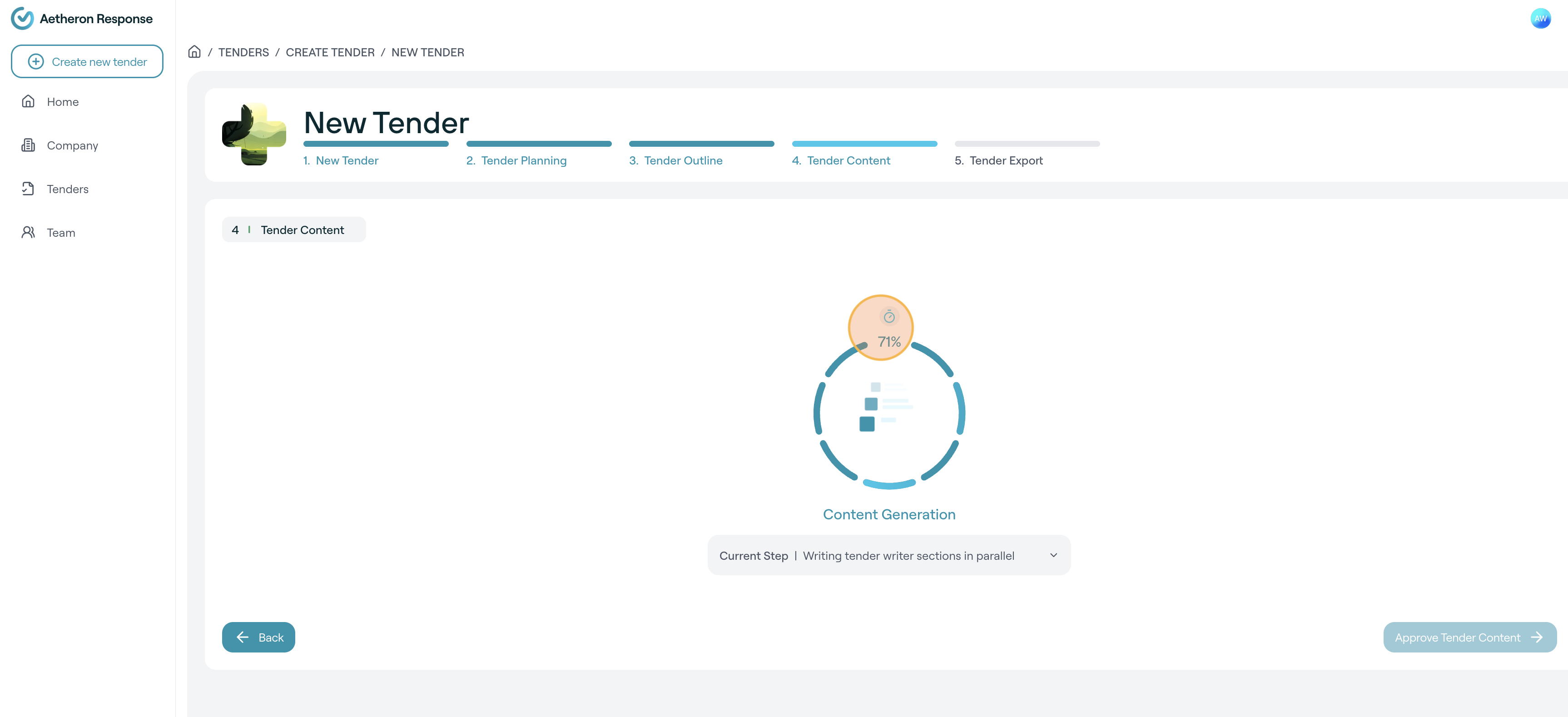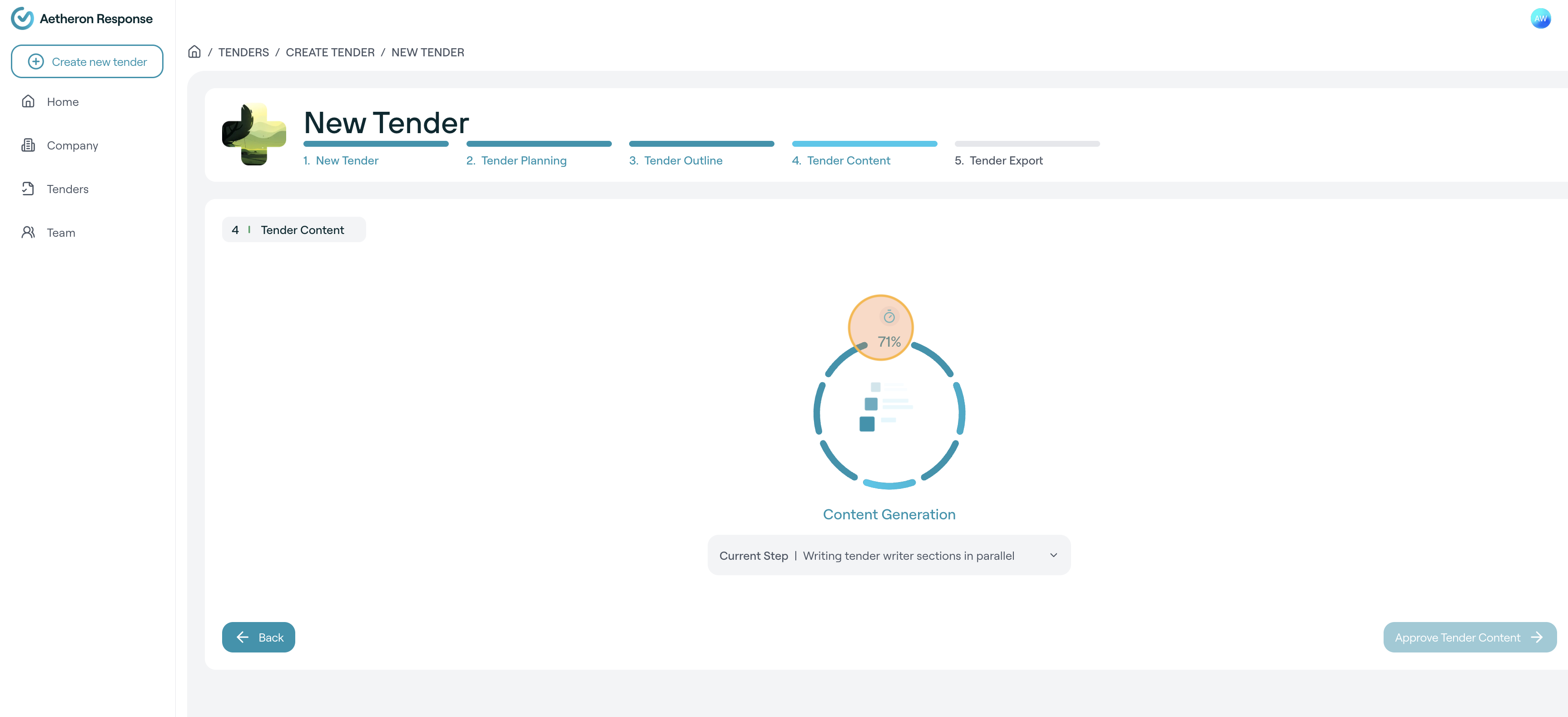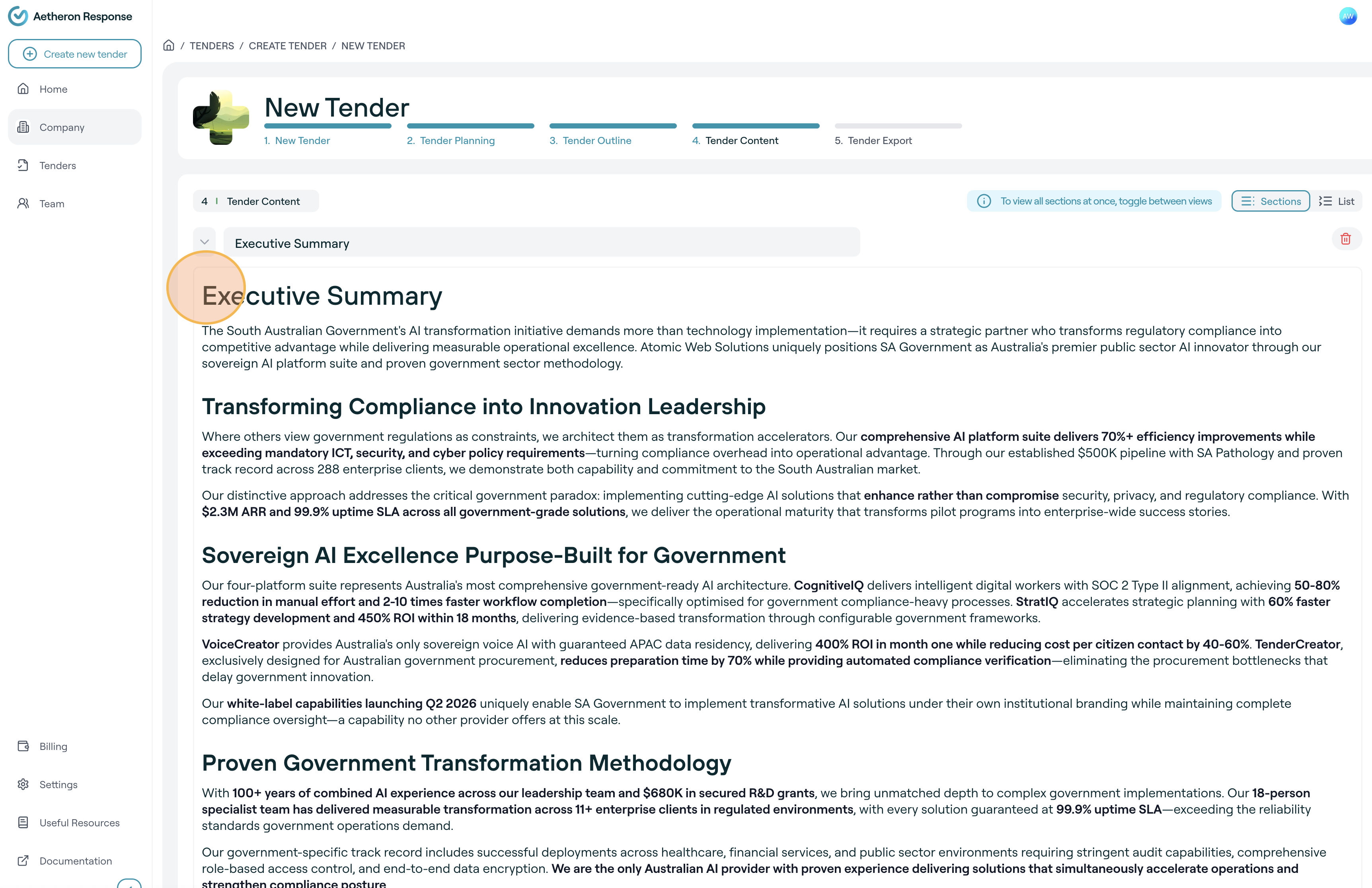Tender Content Phase
The Tender Content phase is where TenderCreator.ai generates the actual written content for your tender response. Using the approved outline, company profile, and win strategies, the AI creates professional, compelling content that addresses all requirements and positions your company competitively.
Overview of Content Generation
Content Generation Process
The content phase involves multiple stages:
- Writer content generation: AI creates initial draft content for each section
- Editor content improvement: AI refines and enhances the generated content
- Content review and editing: You review and customise the content as needed
- Content approval: Final approval before moving to export phase
What Gets Generated
During content generation, the AI creates:
- Section-by-section content: Detailed written content for each outline section
- Requirement responses: Specific responses to all RFT requirements
- Win theme integration: Strategic messaging woven throughout content
- Company positioning: Your capabilities and experience highlighted appropriately

Content Generation Stages
Stage 1: Writer Content Generation
The first stage involves the AI "writer" creating initial content:
Generation Progress
You'll see progress indicators showing:
- Circular progress indicator: Visual representation of completion (starts at 0%)
- Current step status: "Content Editing" or specific section indicator
- Processing message: Clear indication that generation is in progress
- Navigation controls: Back button to return to outline if needed
What the Writer Creates
The AI writer generates:
- Executive summaries: High-level overview and strategic positioning
- Technical content: Detailed responses to technical requirements
- Experience sections: Relevant case studies and project examples
- Compliance content: Addressing mandatory and weighted requirements
Stage 2: Editor Content Enhancement
After writer completion, the AI editor improves the content:
Editing Process
The editor focuses on:
- Content quality: Improving clarity, flow, and professional tone
- Strategic alignment: Ensuring win themes are effectively integrated
- Requirement coverage: Verifying all requirements are fully addressed
- Consistency: Maintaining consistent messaging throughout
The editing stage enhances language quality with professional, compelling writing style, structure optimisation for logical flow, evidence integration with better use of company examples, and competitive positioning with stronger differentiation.
Viewing and Managing Content
Content Display Options
Once content is generated, you have viewing options:
Sections View
- Section navigation: Toggle between "Sections" and "List" views
- Individual sections: Click on each section to view detailed content
- Progress tracking: Visual indicators of content completion
- Edit capabilities: Access to modify and enhance content
List View
- Comprehensive overview: See all content in a continuous format
- Easy navigation: Scroll through entire tender response
- Quick reference: Overview of complete document structure
- Print-friendly: Better for reviewing full document

Section-by-Section Content Review
Section Content Structure
Each section typically includes:
- Section heading: Clear, professional title
- Strategic introduction: Opening that sets context and positioning
- Requirement responses: Detailed responses to assigned requirements
- Company evidence: Relevant examples, case studies, and capabilities
- Win theme integration: Strategic messaging woven throughout
Example Section Content
Based on the generated content, sections might include:
Executive Summary and Strategic Alignment
The section opens with strategic positioning and includes comprehensive coverage of government transformation challenges, sovereign cloud architecture and security capabilities, service excellence partnerships and operational advantages, and zero-downtime transformation methodology.
Understanding Your Requirements
This section demonstrates comprehension through detailed analysis of RFT requirements, compliance approach for mandatory requirements, risk mitigation strategies, and technical solution alignment.
Content Quality and Completeness
Content Quality Indicators
Look for these quality markers:
- Comprehensive coverage: All requirements thoroughly addressed
- Strategic messaging: Win themes effectively integrated
- Professional tone: Appropriate language for tender submission
- Specific examples: Concrete evidence and case studies
- Compliance clarity: Clear addressing of mandatory requirements
Reviewing Generated Content
When reviewing content, check for:
- Accuracy: Ensure all information about your company is correct
- Relevance: Verify content aligns with RFT requirements
- Completeness: Confirm all assigned requirements are addressed
- Strategic alignment: Ensure win themes are effectively communicated

Editing and Customising Content
Making Content Changes
You can customise the generated content:
Section-Level Editing
- Edit entire sections: Modify large blocks of content
- Adjust strategic messaging: Refine win theme integration
- Add specific examples: Include additional case studies or evidence
- Enhance differentiation: Strengthen competitive positioning
Detailed Content Editing
- Paragraph-level changes: Refine specific content areas
- Language improvements: Enhance clarity and impact
- Technical details: Add or modify technical specifications
- Compliance emphasis: Strengthen mandatory requirement responses
Content Editing Best Practices
Maintaining Quality
- Professional tone: Keep language appropriate for tender evaluation
- Factual accuracy: Ensure all claims can be substantiated
- Strategic consistency: Maintain alignment with win themes
- Requirement focus: Ensure responses directly address RFT requirements
Enhancing Competitiveness
- Specific evidence: Include concrete examples and metrics
- Differentiation: Highlight unique capabilities and advantages
- Client benefits: Focus on value delivered to the client
- Risk mitigation: Address potential concerns proactively
Content Approval Process
Reviewing Complete Content
Before proceeding to export:
Final Content Review
- Complete read-through: Review entire tender response
- Requirement verification: Ensure all requirements are addressed
- Quality check: Verify professional standards are met
- Strategic alignment: Confirm win themes are effectively communicated
Approval Considerations
- Content accuracy: All company information is correct and current
- Compliance completeness: All mandatory requirements are fully addressed
- Strategic positioning: Win themes support competitive advantage
- Professional presentation: Content meets tender submission standards
Content Approval Options
Once satisfied with content:
- Approve content: Proceed to export phase
- Return for edits: Make additional modifications if needed
- Save draft: Preserve current state for later completion
- Generate additions: Create supplementary content if needed
Advanced Content Features
Content Sections and Organisation
The generated content typically includes:
Executive Level Content
- Executive summary: High-level strategic overview
- Value proposition: Clear articulation of benefits
- Strategic alignment: Connection to client objectives
- Competitive differentiation: Unique advantages and capabilities
Technical Content
- Solution architecture: Detailed technical approach
- Implementation methodology: Step-by-step delivery approach
- Technology specifications: Technical capabilities and tools
- Integration approach: How solution fits with existing systems
Experience and Capability Content
- Relevant case studies: Similar project examples
- Team qualifications: Key personnel and expertise
- Company credentials: Certifications and qualifications
- Performance metrics: Quantifiable results and outcomes
Win Theme Integration Examples
Strategic themes are woven throughout content:
Theme: "Unified Security-First Cloud Native Transformation at Scale"
- Executive summary: Positioning as only provider with proven large-scale capability
- Technical sections: Detailed security architecture and zero-trust implementation
- Experience sections: Examples of successful 40+ location transformations
- Risk mitigation: Proven track record of maintaining uptime during migration
Theme: "Continuous Service Excellence Partnership"
- Service approach: 24/7 support and proactive monitoring capabilities
- Relationship model: Partnership approach vs. vendor relationship
- Performance metrics: Service level achievements and customer satisfaction
- Operational excellence: Proven service delivery methodologies
Content Generation Tips and Best Practices
Optimising Content Quality
Before Generation
- Complete company profile: Ensure all relevant documents are uploaded
- Accurate requirements: Verify requirements analysis is comprehensive
- Clear win themes: Develop focused, compelling strategic themes
- Strategic outline: Create well-organised section structure
During Review
- Thorough reading: Don't rush through content review
- Requirement mapping: Verify each requirement is adequately addressed
- Evidence verification: Ensure all examples and metrics are accurate
- Strategic consistency: Check that messaging aligns throughout
Content Enhancement
- Add specificity: Include concrete examples and quantifiable results
- Strengthen differentiation: Emphasise unique capabilities and advantages
- Address concerns: Proactively mitigate potential evaluation concerns
- Client focus: Ensure content emphasises client benefits and outcomes
Common Content Issues and Solutions
Generic Content
Problem: Content feels generic or template-like
Solution:
- Add specific company examples and case studies
- Include quantifiable metrics and results
- Enhance win theme integration
- Customise language to reflect company culture
Missing Requirements
Problem: Some requirements not adequately addressed
Solution:
- Review requirements mapping in outline
- Add specific content sections for missed requirements
- Enhance existing responses with more detail
- Cross-reference RFT to ensure completeness
Weak Competitive Positioning
Problem: Content doesn't differentiate from competitors
Solution:
- Strengthen win theme messaging
- Add unique capability examples
- Include competitive advantages and differentiators
- Enhance value proposition clarity
Troubleshooting Content Generation
Common Generation Issues
Content Not Generating
If content generation fails or stalls:
- Check credits: Ensure sufficient AI credits for generation
- Verify outline: Confirm outline is complete and approved
- Internet connection: Ensure stable connectivity
- System status: Check platform maintenance via our Status page
Low-Quality Content
If generated content quality is poor:
- Review company profile: Ensure comprehensive profile content
- Check requirements quality: Verify requirement extraction accuracy
- Enhance win themes: Develop more specific and compelling themes
- Regenerate sections: Try generating content again
Content Doesn't Match Company
If content doesn't reflect your company accurately:
- Update company profile: Add missing capabilities and examples
- Enhance mini profiles: Improve specific capability sections
- Customise content: Edit generated content to better reflect company
- Upload additional documents: Provide more comprehensive company information
Getting Help with Content
- Technical issues: Contact support via our Support guide
- Content quality: Guidance on improving generated content
- Best practices: Tips for optimising content generation
- Custom requirements: Assistance with unique or complex requirements
Updated 19 days ago
